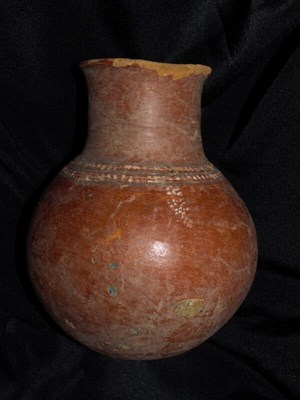
U.S. Immigration and Customs Enforcement’s (ICE) Homeland Security Investigations (HSI), in conjunction with the U.S. Department of State, repatriated a trove of stolen artifacts to the Republic of Mali on November 22, 2021.
U.S. Immigration and Customs Enforcement’s (ICE) Homeland Security Investigations (HSI), in conjunction with the U.S. Department of State, repatriated a trove of stolen artifacts to the Republic of Mali Nov. 22. The artifacts were transferred from HSI to Ambassador Issa Konfourou, permanent representative of Mali to the United Nations.
Among the repatriated artifacts were six large funerary urns (circa 900-1700 A.D.); a comb-impressed red slip double cup vessel (circa 800-1500 A.D.); a high-necked polychrome pot (circa 1100-1400 A.D.); and 913 ground and flax stones and axe heads from the Neolithic Period.
Following the repatriation, HSI Houston Special Agent in Charge Mark Dawson discussed why it is important to return cultural antiquities to their country of origin.
The artifacts first came to HSI’s attention in March 2009, when U.S. Customs and Border Protection (CBP) contacted HSI Houston to let them know that they had encountered a suspicious container at the Port of Houston. The container, which originated from Mali, claimed to be carrying replica cultural items. Upon further inspection, the items appeared to be authentic and were covered in blood and fecal matter, which sent red flags to HSI and CBP officials for possible antiquities smuggling.
To investigate the matter further, HSI Houston brought in Dr. Susan McIntosh, a Rice University professor and one of the world’s foremost experts on west African cultural antiquities. McIntosh conducted a thorough examination of the artifacts and issued an official report in June 2009, which concluded that the items were stolen cultural antiquities from the Republic of Mali.
Based on the results of the report, HSI Houston seized the artifacts June 26, 2009, and initiated the forfeiture process. On July 27, 2011, the funerary urns, red slip double cup vessel, and ground and flaxed stones and axe heads were administratively forfeited; on July 12, 2012, the high-necked polychrome pot was administratively forfeited.
Since that time, a period of civil unrest and economic strain on Mali have prevented the artifacts from being returned to their rightful home. However, in June 2020, the U.S. Department of State stepped in to provide a grant to Mali’s National Directorate of Cultural Patrimonyto fund the repatriation and future exhibition of the objects, which made their return possible. The exhibition will form part of a nation-wide outreach campaign for protecting and preserving Mali’s archaeological sites.
“We are proud to work with our colleagues at Homeland Security Investigations to return these important objects to the people of Mali,” said Acting Assistant Secretary Matthew Lussenhop, Bureau of Educational and Cultural Affairs at the U.S. Department of State. “The United States and Mali have worked together for more than 20 years to reduce the illicit trafficking of Malian archaeological objects and to support sustainable protection of heritage sites and collections.”
The United States and Mali are both signatories to the 1970 UNESCO Convention on the Means of Prohibiting and Preventing the Illicit Import, Export and Transfer of Ownership of Cultural Property. Since 1997, the United States has had a bi-lateral agreement with Mali (Ratified in 2007) governing the protection of cultural property. As a result, any attempts to import designated cultural property originating from Mali into the U.S. will result in their seizure as directed under the Cultural Property Implementation Act (CPIA), 19 U.S.C. 2600-2613.
Despite increasingly aggressive enforcement efforts to prevent the theft of cultural heritage and other antiquities, the illicit movement of such items across international borders continues to challenge global law enforcement efforts to reduce the trafficking of such property. Trafficking in antiquities is estimated to be a multi-billion-dollar transnational criminal enterprise.
HSI, through its 80 offices in 53 countries, works closely with foreign governments to conduct joint investigations, and is committed to pursuing a strategy to combat transnational organized crime related to the illicit trafficking of cultural artifacts by targeting high-priority organizations and strengthening international law enforcement partnerships. Since 2007, these partnerships have helped HSI repatriate more than 15,000 objects to over 40 countries and institutions.
Members of the public who have information about the illicit distribution of cultural property, as well as the illegal trafficking of artwork, are urged to call the toll-free tip line at 1-866-347-2423 or to complete the online tip form.
HSI is a directorate of ICE and the principal investigative arm of the U.S. Department of Homeland Security (DHS), responsible for investigating transnational crime and threats, specifically those criminal organizations that exploit the global infrastructure through which international trade, travel, and finance move. HSI’s workforce of over 10,400 employees consists of more than 7,100 Special Agents assigned to 220 cities throughout the United States, and 80 overseas locations in 53 countries. HSI’s international presence represents DHS’s largest investigative law enforcement presence abroad and one of the largest international footprints in U.S. law enforcement.

ArtDependence Magazine is an international magazine covering all spheres of contemporary art, as well as modern and classical art.
ArtDependence features the latest art news, highlighting interviews with today’s most influential artists, galleries, curators, collectors, fair directors and individuals at the axis of the arts.
The magazine also covers series of articles and reviews on critical art events, new publications and other foremost happenings in the art world.
If you would like to submit events or editorial content to ArtDependence Magazine, please feel free to reach the magazine via the contact page.